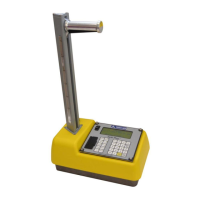
Do you have a question about the Troxler RoadReader 3430 and is the answer not in the manual?
| Display | LCD |
|---|---|
| Power Source | Rechargeable battery |
| Interface | RS-232 |
| Measurement Type | Density and Moisture |
| Moisture Range | 0 to 50% |
| Measurement Depth | Up to 300 mm |
| Operating Temperature | -10°C to 50°C |
| Data Storage | Internal memory |
| Battery Life | 8 hours (typical) |
| Measurement Principle | Nuclear |
Provides an overview of the Model 3440 gauge and its key features and benefits.
Lists and describes the components included with the Model 3440 gauge for user reference.
Details the steps for safely unpacking and inspecting the gauge upon receipt.
Explains the principles of density measurement using direct transmission and backscatter modes.
Describes how the gauge measures moisture content using a neutron source and detector.
Covers gauge calibration procedures and the use of offsets for accurate readings.
Shows a diagram of the gauge and its main components for identification.
Details the layout and functions of the gauge's control panel and keypad.
Explains the different positions of the source rod (SAFE, backscatter, direct transmission).
Outlines the daily checks required to ensure proper operation and safety features.
Describes the procedure for powering on the gauge and its self-test sequence.
Explains how to configure measurement units, count time, and depth mode.
Details the procedure for performing a daily standard count for accuracy verification.
Provides instructions for preparing the test site for accurate measurements.
Guides on how to perform measurements in Soil and Asphalt modes.
Explains how to view stored measurement results using the Recall function.
Overview of the main setup menu options available on the gauge.
Describes how to perform a statistical stability test to validate gauge operation.
Explains how to perform a drift test to check long-term gauge stability.
Covers the Nomograph function for determining thin asphalt overlay density.
Details the Precision function for determining required count time for desired precision.
Discusses optional features like external beeper and GPS that can be added to the gauge.
Introduces the Target menu for setting compaction level references.
Explains how to enable, disable, or store target values like Gmb, Proctor, Gmm.
Explains the purpose of density, moisture, and trench offsets for accurate readings.
Guides on enabling, disabling, or changing the density offset value.
Details how to enter or derive moisture offsets for accurate moisture readings.
Describes how to perform a trench offset for measurements in trenches or near structures.
Overview of managing measurement data using projects, including create, select, view, erase.
Instructions on selecting an existing project to make it active.
Guides on how to view stored measurement results within a project file.
Explains the process of creating a new project for storing measurements.
Details how to erase single or all project files from the gauge memory.
Covers options for printing or uploading project data to a computer or USB drive.
Explains the Auto-Store function for automatic data saving after measurements.
Guides on manually storing measurement data to the active project.
Overview of the Extended menu for advanced settings and options.
Explains how to set and format the gauge's date and time.
Guides on entering or changing the three-character user ID for measurements.
Explains how to enter or change the customer name associated with measurements.
Covers viewing source decay information and its impact on measurements.
Explains how to clear all stored standard counts from the gauge memory.
Describes how to adjust the timing of low battery warning alerts.
Guides on resetting user setup values to factory defaults.
Provides solutions for common gauge problems and error messages.
Explains how to adjust the gauge's display contrast for better readability.
Discusses battery types, status display, and typical operating life.
Details the procedure for charging the gauge's rechargeable NiMH batteries.
Outlines procedures for keeping the gauge clean and in good working order.
Explains how to lubricate the source rod bearing for smooth operation.
Guides on replacing gaskets and O-rings to maintain gauge integrity.
Provides instructions and requirements for sending the gauge for repair.
Lists major parts and accessories available for purchase.
Lists precision and error values for density and moisture measurements.
Details specifications related to the gauge's radioactive sources and shielding.
Covers power, current consumption, display, and data format specifications.
Provides physical dimensions, weight, temperature, and humidity limits.
Outlines the major requirements for transporting a nuclear gauge in the US.
Details regulations for transporting the gauge within Canada.
Discusses radiation dose, safety limits, and exposure control methods.
Details essential safety measures for operating and inspecting the gauge.
Covers actions for incidents, disposal, and regulatory compliance.
Explains procedures for leak testing and source rod integrity checks.
Shows radiation dose rates at different points around the gauge and transport case.
Provides conversion factors between English and SI units for measurements.
Lists conversion factors for radioactivity units from millicuries to gigabequerels.
Lists standards to which the gauge conforms, relevant for CE marking.
Provides specific safety warnings applicable to gauges used in European countries.
Discusses the accuracy of GPS readings and factors affecting them, including WAAS.
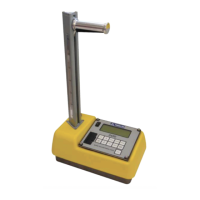
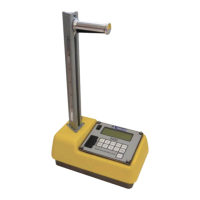


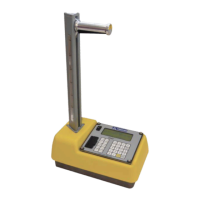
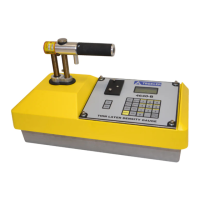




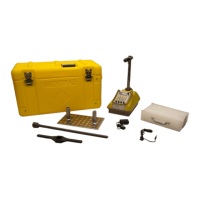

